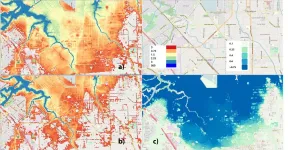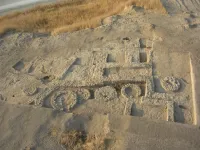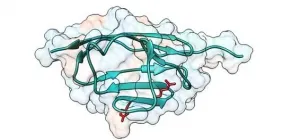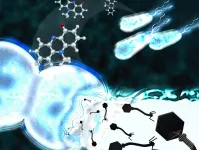Study of harvey flooding aids in quantifying climate change
2021-06-10
(Press-News.org) How much do the effects of climate change contribute to extreme weather events? It's hard to say--the variables involved are plentiful, each event is unique, and we can only do so much to investigate what didn't happen. But a new paper from Lawrence Berkeley National Laboratory (Berkeley Lab) climate scientist Michael Wehner investigates the question for one particular element of one significant storm and makes the results available to those who lived through it.
In the paper, "Attributable human-induced changes in the magnitude of flooding in the Houston, Texas region during Hurricane Harvey," published May 19 in Climatic Change, Wehner and Christopher Sampson from Fathom Bristol used a hydraulic model--a mathematical model that can analyze the flow of fluid through a particular system of natural or human-made channels--to consider the degree to which human-caused climate change may have affected flooding in and around Houston during the massive 2017 storm, and the ways in which that flooding was distributed. Wehner and Sampson used resources at the National Energy Research Scientific Computing Center (NERSC) to quantify the increase in Houston flood area and depth from the hydraulic model output and to host a portal where other scientists and the public can access the data for their own use.
From August 26 through August 31, 2017, Hurricane Harvey stalled over the Houston area, flooding 154,000 structures and 600,000 cars; 37,000 people were displaced, and more than 70 died in the floodwaters. Adjusted for inflation, it was the second-most financially expensive tropical storm in United States history, costing between $85 billion and $125 billion.
Using previously published estimates (Risser and Wehner 2017; Von Oldenborg et al 2017; Wang et al 2018) stating a range of a 7% to 38% increase in precipitation during Hurricane Harvey due to climate change, Wehner and Sampson applied a hydraulic model to produce a range of simulations showing the distribution of flooding around the Houston area, illustrating a variety of outcomes for different levels of attribution to climate change.
According to Wehner, the computational simplicity of hydraulic models allows for extremely fine resolution simulations --in this case, about 30 meters (100 feet), or approximately the size of a single house and yard. Because of the granularity of the data, residents themselves can use the model to check the flood status of their homes or blocks in different modeled scenarios and see how climate change may have affected them directly.
"[The amount of flooding you experienced] depends a lot on where you are, whether you were victimized by the flood first of all, and then by whether climate change caused that flooding or not," said Wehner. "That's why this is an interesting data set. It's so high-resolution that people can search for their own houses, or at least their own blocks, and see whether their house was flooded because of climate change--at least according to these simulations."
That's part of the impetus of this study, he emphasized: not just publishing the results, but making them easily available to other professional scientists, community scientists, and any member of the public who wants to look at them. For example, Wehner has already begun sharing his data with a team of social scientists who plan to use the data to study the disproportionate distribution of impacts across ethnic groups in Houston. On a broader scale, a public-facing portal hosted at NERSC offers Wehner and Sampson's data in easily downloadable form, in addition to links to free software.
"It's a scientific paper, but it's really motivated as a public outreach," said Wehner. "I'm trying to empower the public to go out and do their own finding, for people to say, 'I want to know if climate change impacted my neighborhood.'"
In addition to community science and passing data on to other researchers, this study may also contribute to research on the economic impacts of climate change.
"At the end of the day, our best estimate is that 14% to 15% of the cost of flooding during Hurricane Harvey is because of climate change, which doesn't sound like a whole lot...but $13 billion does. And that's going to grow as climate change continues," said Wehner.
INFORMATION:
[Attachments] See images for this press release:

ELSE PRESS RELEASES FROM THIS DATE:
2021-06-10
Even on a good day, DNA is constantly getting damaged.
Nicks, scratches, breaks: the delicate strands that carry life's genetic code take a beating as they jumble about in the course of their work. If left untreated, errors accumulate, with fatal consequences -- such as cancerous tumors -- for the cell and the organism.
This is where two key proteins come to the rescue: PARP -- or poly ADP ribose polymerase -- acts as a marker for a trouble spot, allowing XRCC1 -- or X-ray repair cross-complementing protein 1 -- to zoom in and begin a repair.
This much has been known for some time and was even recognized in the 2015 Nobel prizes ...
2021-06-10
A team of archaeologists from the Hebrew University of Jerusalem (HU) made a rare discovery when they unearthed a small clay seal impression dating back some 7000 years. The impression, with two different geometric stamps imprinted on it, was discovered in Tel Tsaf, a prehistoric village located in Israel's Beit She'an Valley up north.
The discovery was made as part of a dig that took place between 2004 and 2007 and was led by HU's Professor Yosef Garfinkel along with two of his students, Professor David Ben Shlomo and Dr. Michael Freikman, both of whom are now researchers at Ariel University. One hundred and fifty clay sealings were originally found at the site, with one being particularly rare and of distinct, historic importance. The object ...
2021-06-10
LA JOLLA--(June 10, 2021) In order for cancer to grow and spread, it has to evade detection by our immune cells, particularly specialized "killer" T cells. Salk researchers led by Professor Susan Kaech have found that the environment inside tumors (the tumor microenvironment) contains an abundance of oxidized fat molecules, which, when ingested by the killer T cells, suppresses their ability to kill cancer cells. In a vicious cycle, those T cells, in need of energy, increase the level of a cellular fat transporter, CD36, that unfortunately saturates them with even more oxidized fat and further curtails their anti-tumor functions.
The discovery, published online in Immunity on June 7, 2021, suggests new pathways for safeguarding the immune system's ...
2021-06-10
Scientists are hoping the RNA of an obscure infection can one day be used like a Trojan horse to deliver life-saving treatments to citrus trees.
The infection, citrus yellow vein disease, was discovered 64 years ago in Riverside and has never been seen elsewhere in the world. Decades later, UC Riverside researchers have finally unraveled the associated pathogen's genetic codes -- a significant step toward harnessing its unique properties.
A paper describing this work was published recently in the journal Frontiers in Microbiology. It opens the door to testing whether this apparently ...
2021-06-10
Scientists at the Centro Nacional de Investigaciones Cardiovasculares (CNIC) have described a potential disease-causing mechanism in hypertrophic cardiomyopathy (HCM), the most frequent hereditary disease of the heart. The study, published in the journal ACS Nano, provides the first description of an association between this disease and mechanical alterations to a component of the contractile machinery of the heart.
The heart muscle is under constant mechanical stress throughout life as it contracts to pump blood to the body. The laboratory led by Dr. Jorge Alegre-Cebollada investigates how the mechanical properties of the cardiac proteins determine the physiological behavior of this muscle and how alterations to these properties lead to the appearance of diseases like ...
2021-06-10
This targeted control of phages provides entirely new biotechnological and therapeutic approaches, e.g. for phage therapies. The results produced in the context of an ERC grant have been published in the Journal of the American Chemical Society.
The human body and its microbiota harbour a large amount of phages. These infect bacteria as virus particles to ensure their own survival. One of their strategies is to integrate into the bacterial genome and multiply via bacterial cell division. However, external signal molecules can trigger the phages' sudden awakening from their dormant ...
2021-06-10
Imagine you're a fisherman living by a lake with a rowboat. Every day, you row out on the calm waters and life is good. But then your family grows, and you need more fish, so you go to the nearby river. Then, you realize you go farther and faster on the river. You can't take your little rowboat out there - it's not built for those currents. So, you learn everything you can about how rivers work and build a better boat. Life is good again...until you realize you need to go farther still, out on the ocean. But ocean rules are nothing like river rules. Now you have to learn how ocean currents work, and then ...
2021-06-10
DARIEN, IL - Findings from a recent study show that patients with untreated, moderate to severe obstructive sleep apnea had a higher risk of experiencing a cardiovascular event, but the risk of incident heart problems was decreased in those who used CPAP therapy.
Results show that people with moderate to severe sleep apnea and no record of CPAP use were 71% more likely than those without sleep apnea to experience incident myocardial infarction, stroke, unstable angina, heart failure or cardiovascular death. Compared with the risk of heart problems in people with untreated sleep apnea, the risk of experiencing a cardiovascular event was 32% lower ...
2021-06-10
ITHACA, N.Y. - The Noceto Vasca Votiva is a unique wood structure that was unearthed on a small hill in northern Italy in 2005. Built primarily of oak and slightly larger than a backyard swimming pool, the exact purpose of the in-ground structure has remained a mystery, as has the date of its construction. Italian researchers estimated its origins go back to the late Middle Bronze Age, sometime between 1600 and 1300 B.C.
While that gap might not seem huge, in archeological terms it's like comparing the culture that invented the steam engine with the one that produced the iPad.
A Cornell University team led by Sturt Manning, Distinguished ...
2021-06-10
Fast radio bursts, or FRBs, blaze for a few milliseconds before vanishing without a trace. Their origins are unknown, and their appearance is unpredictable. In the decade following their discovery in 2007, only 140 FRBs had been seen. Now, thanks to the launch of a large stationary telescope in the interior of British Columbia in 2018, the number of new FRBs detected has almost quadrupled - for a total of 535. Moreover, the Canadian Hydrogen Intensity Mapping Experiment (CHIME/FRB), a McGill-led inter-university collaboration, has put together the first CHIME/FRB catalogue, which will be presented this week at the American Astronomical Society Meeting.
CHIME is unique in that ...
LAST 30 PRESS RELEASES:
[Press-News.org] Study of harvey flooding aids in quantifying climate change




